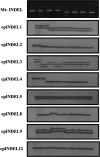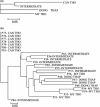Genetic diversity among perennial wild rice Oryza rufipogon Griff., in the Mekong Delta
- PMID: 30891229
- PMCID: PMC6405534
- DOI: 10.1002/ece3.4978
Genetic diversity among perennial wild rice Oryza rufipogon Griff., in the Mekong Delta
Abstract
Oryza rufipogon Griff. is a perennial species of wild rice widely distributed along the channels and rivers of the Mekong Delta, Vietnam. This study attempted to find centers of diversity among wild rice populations in this area and their inter-relationships. The highest genetic diversity was found in the Dong Thap population and the lowest in the Can Tho population. Maternal diversity evaluated using chloroplast INDELs detected ten plastid types, five of which were novel relative to other Asian countries. The mitochondrial genome suggested two unique deletions. One 699-bp deletion via short tandem repeats was accompanied by another deletion including orf153. All accessions carrying the mitochondrial type were found in a particular plastid type. This unique maternal lineage was confined to specific channels where it showed vigorous vegetative growth in comparison to upstream areas where various maternal lineages and maximum genetic diversity occurred. This area along the Mekong Delta is a center of not only nuclear but also maternal diversity.
Keywords: Mekong Delta; Oryza rufipogon; clonal propagation; maternal lineage; mitochondrial rearrangement.
Conflict of interest statement
None declared.
Figures





Similar articles
-
Diverse genetic variation in maternal lineages with high heterogeneity among in situ-conserved wild rice (Oryza rufipogon Griff.) developed in Thailand.Breed Sci. 2018 Dec;68(5):614-621. doi: 10.1270/jsbbs.16105. Epub 2018 Nov 28. Breed Sci. 2018. PMID: 30697123 Free PMC article.
-
Genetic diversity of wild rice accessions (Oryza rufipogon Griff.) in Guangdong and Hainan Provinces, China, and construction of a wild rice core collection.Front Plant Sci. 2022 Oct 3;13:999454. doi: 10.3389/fpls.2022.999454. eCollection 2022. Front Plant Sci. 2022. PMID: 36262660 Free PMC article.
-
Molecular relationships between Australian annual wild rice, Oryza meridionalis, and two related perennial forms.Rice (N Y). 2013 Oct 28;6(1):26. doi: 10.1186/1939-8433-6-26. Rice (N Y). 2013. PMID: 24280095 Free PMC article.
-
Genetic differentiation for nuclear, mitochondrial and chloroplast genomes in common wild rice ( Oryza rufipogon Griff.) and cultivated rice ( Oryza sativa L.).Theor Appl Genet. 2002 Jun;104(8):1335-1345. doi: 10.1007/s00122-002-0878-4. Epub 2002 Apr 10. Theor Appl Genet. 2002. PMID: 12582589
-
Inconsistent diversities between nuclear and plastid genomes of AA genome species in the genus Oryza.Genes Genet Syst. 2015;90(5):269-81. doi: 10.1266/ggs.14-00063. Epub 2015 Dec 18. Genes Genet Syst. 2015. PMID: 26687860
Cited by
-
Current status of genomic resources on wild relatives of rice.Breed Sci. 2020 Apr;70(2):135-144. doi: 10.1270/jsbbs.19064. Epub 2020 Mar 19. Breed Sci. 2020. PMID: 32523396 Free PMC article.
-
Detection of QTLs Regulating Six Agronomic Traits of Rice Based on Chromosome Segment Substitution Lines of Common Wild Rice (Oryza rufipogon Griff.) and Mapping of qPH1.1 and qLMC6.1.Biomolecules. 2022 Dec 11;12(12):1850. doi: 10.3390/biom12121850. Biomolecules. 2022. PMID: 36551278 Free PMC article.
References
-
- Akimoto, M. , Shimamoto, Y. , & Morishima, H. (1999). The extinction of genetic resources of Asian wild rice Oryza rufipogon Griff.: A case study in Thailand. Genetic Resources and Crop Evolution, 46, 419–425.
-
- Barbier, P. (1989). Genetic variation and ecotypic differentiation in the wild rice species Oryza rufipogon. I. Population differentiation in life‐history traits and isozymic loci. The Japanese Journal of Genetics, 64, 259–271.
-
- Brar, D. S. (2003). Utilization of wild species of genus Oryza in rice improvement. In Nanda J. S. & Sharma S. D. (Eds.), Monograph on genus Oryza (pp. 283–309). Enfield, UK: Science Publishers.
-
- Brar, D. S. , & Khush, G. S. (1997). Alien introgression in rice. Plant Molecular Biology, 35, 35–47. - PubMed
-
- Buu, B. C. (1994). Diversification of genetic materials in rice bredding in the Mekong Delta In Proceedings of the Annual Workshop: Cropping systems for agricultural diversification in southern Vietnam (pp. 67–69). 9–10 Dec, 1993, Can Tho, Vietnam: CLRRI.
LinkOut - more resources
Full Text Sources

